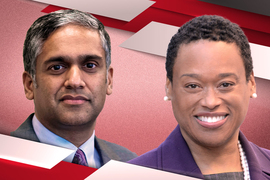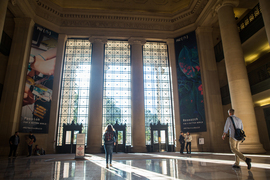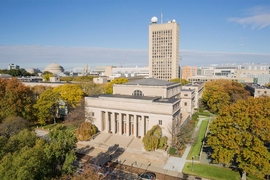This is part two in a series of interviews with co-chairs of Task Force 2021 and Beyond workstreams. Part one is available here.
MIT’s Task Force 2021 and Beyond has been at work for seven months, charged by President L. Rafael Reif with exploring “how MIT might invent a thriving new future” in a post-Covid world. The effort’s Finance and Data Workstream, which looked at the future of MIT’s finances, was co-chaired by Glenn Ellison, the Gregory K. Palm Professor of Economics, and Danielle Khoury, MIT’s controller.
Ellison and Khoury spoke with MIT News about the likely intermediate- to long-term financial impacts Covid will have on MIT, the themes that arose in their group’s conversations, and the changes that might arise if some of their proposals are adopted.
Q: What changes — due to the events of this past year — do you think will have the most significant impact on MIT’s finances?
Ellison: MIT has incurred very large operating expenses and revenue stream losses over the past year plus, as we’ve coped with the pandemic. Although it’s a lot of money, the benefit of a large endowment like ours is that you do not need to react much to one-time shocks.
It’s hard to predict how the pandemic will evolve. If we don’t go back to “normal” soon, then Covid-related costs could be a big concern.
Induced changes in how people think about online and in-person education could also spur changes in the activities MIT wants to undertake. This could also have big financial implications.
Our workstream, however, was not so much trying to predict the future. Rather, we were thinking of improvements to financial practices that we would want to make regardless of how things turn out.
Khoury: More generally, we are seeing that the Institute’s sources of funding are changing over time. Pre-pandemic, we had been seeing a flattening in research funding from the federal government, and an increase in support from industrial and foundation sponsors, as well as an increase in the percentage of our operations that are funded through philanthropic revenue sources, such as donations and investment income earned on our endowment.
The impact of the pandemic on MIT’s finances will depend on the length of the pandemic and how our operating model might permanently change in its wake. These are still open questions. But we do have a strong understanding of the financial challenges that we would like to tackle, such as financial support for students and our ability to fund research in cases where the sponsor does not cover the fully loaded costs of the project (inclusive of facilities and administration expenses).
Q: What were themes that emerged in your group’s discussions, and in the ideas that your group put forward?
Ellison: One of the themes was the importance of rationalizing internal accounting costs and trying to align them as well as possible with true costs to MIT so that departments can allocate resources efficiently. Graduate student funding arose as an important area to address.
Another was that that there seem to be a number of places where additional spending would have big benefits. This means that there is a big benefit to having more unrestricted funds and we should work hard to increase the flow of unrestricted funds available to the provost and the general Institute budget.
Khoury: One additional theme was the availability of undergraduate financial aid funding and its impact on student debt. Student debt has been a much-discussed topic both inside and outside of MIT in recent years.
Another was to consider growing the Institute’s professional eduction and online program offerings, as these activities generally offer more flexible funding streams compared to sponsored research.
Q: If some of your group’s key ideas are implemented, how would MIT be different in 10 years?
Khoury: Across the board, our group hopes to develop funding models that will be more flexible for the MIT of the future. While our overall financial picture is enviable, Covid has focused our attention on revisiting some of our long-term financial thinking. It’s a prudent moment for us to think about developing more robust funding options for our graduate students, for our research enterprise, and for supporting other critical Institute activities.










